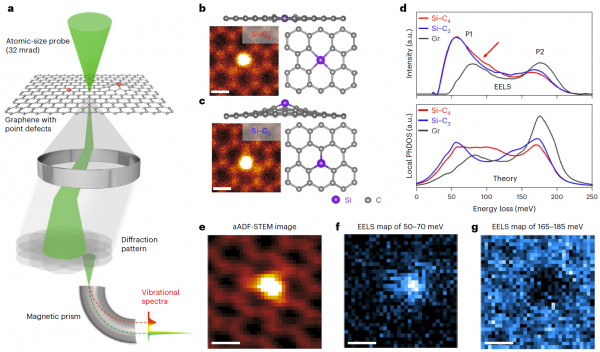Researchers from Vanderbilt University and University of the Chinese Academy of Sciences have made a significant advancement in understanding the correlation of the vibrational patterns of atoms at the level of chemical bonds in conducting materials silicon and graphene.

Atomic vibrational patterns are necessary to understand because they underlie a material’s ability to conduct heat, among other things. Heat management is critical to keeping the chips behind computers and phones operational. Heat management is also necessary for nanophotonics, a component of nanotechnology that includes new optical devices in the infrared.

The team, led by Sokrates T. Pantelides, University Distinguished Professor of Physics and Engineering, William A. and Nancy F. McMinn Professor of Physics and professor of electrical engineering, and Wu Zhou, physical sciences professor at UCAS, successfully push the sensitivity of single-atom vibrational spectroscopy to the chemical-bonding-configuration extreme.

The researchers measured the vibrational patterns of individual atoms around silicon impurities in graphene, a step that can revolutionize the design of heat-conducting materials and structures that keep devices and batteries powering everyday technologies operational. The new precise measurements of the vibrational properties of graphene reveal novel understanding of the “wonder material,” with broad implications for graphene’s use in all devices from nanoantennae—used for biological and chemical sensing—to supercomputers.
Vanderbilt postdoctoral scholar and co-first author De-Liang Bao was the key contributor to the theoretical component of the paper. UCAS graduate students, Mingquan Xu and Aowen Li, were key contributors to the experimental component. The good correlation between the experimental data and quantum calculations represents a breakthrough in understanding the role of local chemical bonding in controlling vibrational properties.
A link to a news release issued by UCAS containing more details is here. The article, “Single-atom vibrational spectroscopy with chemical-bonding sensitivity” was published in the journal Nature Materials.
The work at Vanderbilt University was supported by the U.S. Department of Energy Office of Science, Basic Energy Sciences, Materials Science and Engineering grant DE-FG02-09ER46554 and the McMinn Endowment.